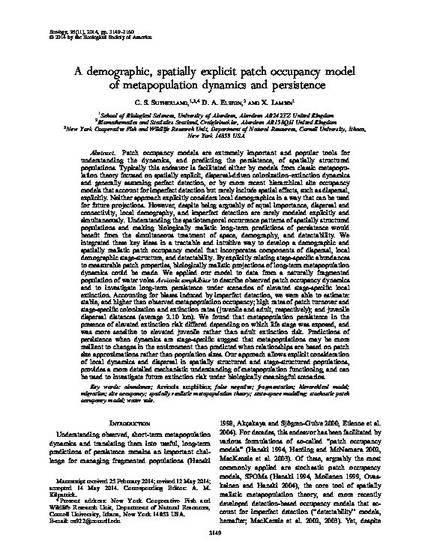
Article
A demographic, spatially explicit patch occupancy model of metapopulation dynamics and persistence
Ecology
(2014)
Abstract
Patch occupancy models are extremely important and popular tools for
understanding the dynamics, and predicting the persistence, of spatially structured
populations. Typically this endeavor is facilitated either by models from classic metapopulation
theory focused on spatially explicit, dispersal-driven colonization–extinction dynamics
and generally assuming perfect detection, or by more recent hierarchical site occupancy
models that account for imperfect detection but rarely include spatial effects, such as dispersal,
explicitly. Neither approach explicitly considers local demographics in a way that can be used
for future projections. However, despite being arguably of equal importance, dispersal and
connectivity, local demography, and imperfect detection are rarely modeled explicitly and
simultaneously. Understanding the spatiotemporal occurrence patterns of spatially structured
populations and making biologically realistic long-term predictions of persistence would
benefit from the simultaneous treatment of space, demography, and detectability. We
integrated these key ideas in a tractable and intuitive way to develop a demographic and
spatially realistic patch occupancy model that incorporates components of dispersal, local
demographic stage-structure, and detectability. By explicitly relating stage-specific abundances
to measurable patch properties, biologically realistic projections of long-term metapopulation
dynamics could be made. We applied our model to data from a naturally fragmented
population of water voles Arvicola amphibius to describe observed patch occupancy dynamics
and to investigate long-term persistence under scenarios of elevated stage-specific local
extinction. Accounting for biases induced by imperfect detection, we were able to estimate:
stable, and higher than observed metapopulation occupancy; high rates of patch turnover and
stage-specific colonization and extinction rates ( juvenile and adult, respectively); and juvenile
dispersal distances (average 2.10 km). We found that metapopulation persistence in the
presence of elevated extinction risk differed depending on which life stage was exposed, and
was more sensitive to elevated juvenile rather than adult extinction risk. Predictions of
persistence when dynamics are stage-specific suggest that metapopulations may be more
resilient to changes in the environment than predicted when relationships are based on patch
size approximations rather than population sizes. Our approach allows explicit consideration
of local dynamics and dispersal in spatially structured and stage-structured populations,
provides a more detailed mechanistic understanding of metapopulation functioning, and can
be used to investigate future extinction risk under biologically meaningful scenarios.
Keywords
- abundance,
- Arvicola amphibius,
- false negative,
- fragmentation,
- hierarchical model,
- migration,
- site occupancy,
- spatially realistic,
- metapopulation theory,
- state-space modeling,
- stochastic patch occupancy model,
- water vole
Disciplines
- Life Sciences and
- Biology
Publication Date
Fall November 1, 2014
DOI
10.1890/14-0384.1
Citation Information
Chris Sutherland, D. A. Elston and X. Lambin. "A demographic, spatially explicit patch occupancy model of metapopulation dynamics and persistence" Ecology Vol. 95 Iss. 11 (2014) p. 3149 - 3160 Available at: http://works.bepress.com/chris-sutherland/1/
